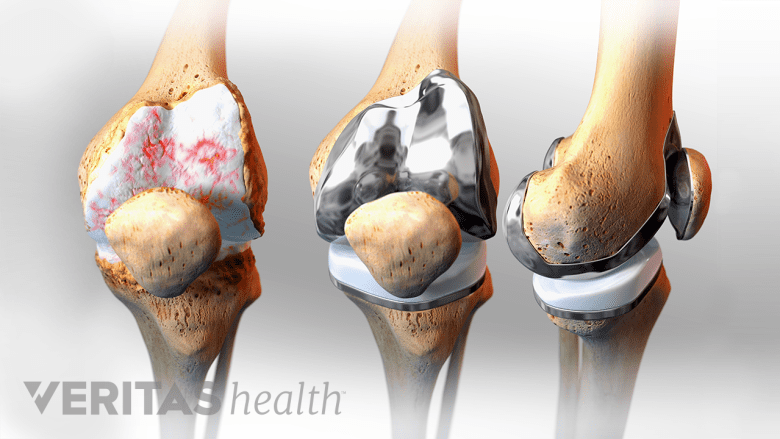The goal of total knee replacement surgery is to relieve knee pain and increase knee function by resurfacing the bones that meet at the knee joint. The surgeon removes damaged portions of bone at the end of the femur (thigh-bone) and top of the tibia (shin-bone) and replaces them with prosthetic components. Some surgeries also resurface the back of the patella, or kneecap.

In a knee replacement surgery, damaged bone is first removed and then a prostheses is attached.
Below is a step-by-step description of a typical total knee replacement surgery. The actual surgery typically lasts for 2 hours per knee.
In This Article:
Knee Replacement Surgery, Step-by-Step Description
Surgical procedures differ depending on the patient’s needs and the surgeon’s approach, but generally the steps are as follows:
- The patient’s vital signs are checked to make sure blood pressure, heart rate, body temperature, and oxygenation levels are normal and surgery can proceed. A mark is made on the knee undergoing surgery.
- Peripheral nerve blocks may be offered by the anesthesia team to aid with early postoperative pain control while allowing muscles to function safely and effectively during physical therapy. The procedure involves injecting numbing medication with ultrasound needle guidance for safe and effective placement around a portion of the femoral nerve. These versatile procedures can be performed before and/or after the surgery. They can also include either a one-time injection lasting 24 to 36 hours or placement of a catheter for repeat infusions over several days.
- Anesthesia is administered. The patient may receive:
- General anesthesia (be put to sleep)
- A spinal nerve block, which will block sensation from the waist down, along with a relaxant
The type of anesthesia a patient receives is usually decided well ahead of time, but may be modified on the day of surgery based on a discussion between the patient and the anesthesiologist.
- The surgeon makes an incision down the center of the knee about 8 to 10 inches long, and then cuts through deeper tissue, including the quadriceps tendon, and flips over the kneecap to access the femur and tibia. (If performing minimally invasive knee replacement, the surgeon will make smaller incisions and use minimally invasive surgical techniques.)
- To improve the surgeon’s ability to access to the joint, the knee is bent to 90 degrees.
- The surgeon uses a bone saw to remove the arthritically damaged areas at bottom of the femur and the top of the tibia. Each bone is reshaped to exactly fit its new prosthesis. Because these cuts must be precise, the surgeon uses either a metal jig or computer assistance to line up the cuts.
- A surgeon may resurface the back of the kneecap, or patella, and attach an implant. A polyethylene component may be attached to facilitate the patella’s gliding against the new joint. Research has not shown a significant difference in outcomes for patients who received patella resurfacing and those who did not.1Breeman S, Campbell M, Dakin H, Fiddian N, Fitzpatrick R, Grant A, Gray A, Johnston L, Maclennan G, Morris R, Murray D; KAT Trial Group. Patellar resurfacing in total knee replacement: five-year clinical and economic results of a large randomized controlled trial. J Bone Joint Surg Am. 2011 Aug 17;93(16):1473-81. PubMed PMID: 22204002.,2Pavlou G, Meyer C, Leonidou A, As-Sultany M, West R, Tsiridis E. Patellar resurfacing in total knee arthroplasty: does design matter? A meta-analysis of 7075 cases. J Bone Joint Surg Am. 2011 Jul 20;93(14):1301-9. PubMed PMID: 21792496. Components are attached to the femur, tibia, and—if applicable—the patella. Typically, these components are affixed using fast-drying bone cement. Cementless components, which allow bone tissue to grow on them and adhere over time, also exist.
See Cemented vs. Cementless Alternatives in Joint Replacement
- A flexible cushion, usually made of polyethylene, is attached on top of the new tibia surfaces. This spacer acts as a shock absorber between the two new prosthetic surfaces.
- The leg is flexed and extended to test the fit of the components and the new knee’s range of motion.
- The surgeon straightens the knee to allow the components, cement, and bone to bond together.
- The surgeon will repair any deep tissue that was cut during surgery and then stitch the skin at the incision.
After surgery, a patient may be taken to a recovery room for a few hours while the surgical anesthesia wears off. Afterwards a patient will be seen by a physical therapist, and if deemed appropriate, could be discharged home on the day of surgery. If the patient is not deemed safe for discharge on the day of surgery, they will be admitted to a hospital room where he or she will spend 1 to 2 days before being discharged.3Activities After Knee Replacement. OrthoInfo, American Academy of Orthopaedic Surgeons. https://orthoinfo.aaos.org/en/recovery/activities-after-knee-replacement/. Last reviewed July 2014. Accessed June 11, 2018.
- 1 Breeman S, Campbell M, Dakin H, Fiddian N, Fitzpatrick R, Grant A, Gray A, Johnston L, Maclennan G, Morris R, Murray D; KAT Trial Group. Patellar resurfacing in total knee replacement: five-year clinical and economic results of a large randomized controlled trial. J Bone Joint Surg Am. 2011 Aug 17;93(16):1473-81. PubMed PMID: 22204002.
- 2 Pavlou G, Meyer C, Leonidou A, As-Sultany M, West R, Tsiridis E. Patellar resurfacing in total knee arthroplasty: does design matter? A meta-analysis of 7075 cases. J Bone Joint Surg Am. 2011 Jul 20;93(14):1301-9. PubMed PMID: 21792496.
- 3 Activities After Knee Replacement. OrthoInfo, American Academy of Orthopaedic Surgeons. https://orthoinfo.aaos.org/en/recovery/activities-after-knee-replacement/. Last reviewed July 2014. Accessed June 11, 2018.

